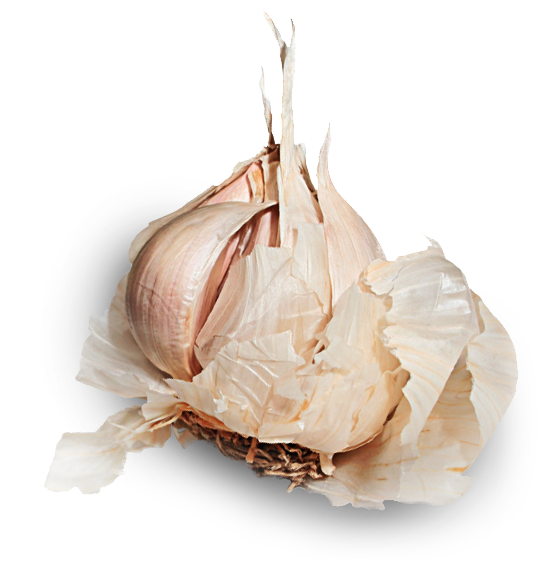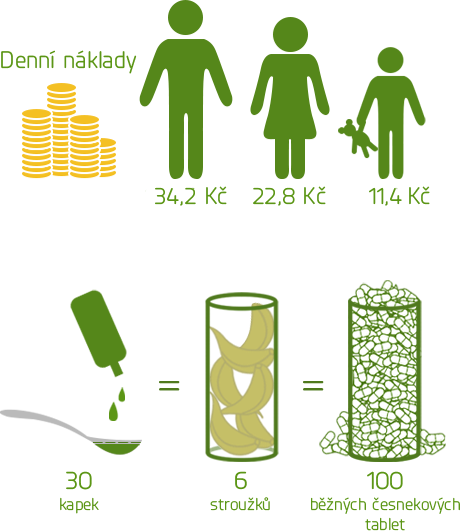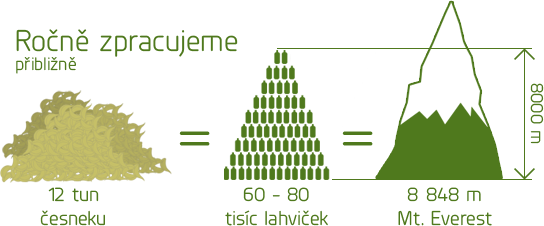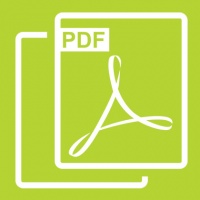



Hledáte originální benefity pro své zaměstnance či klienty?
darujte některý z našich produktů
Jak skladovat čerstvý česnek, aby vydržel celou zimu: Zapomeňte na lednici i omývání, správný postup je jiný!
přečíst celé…I když antibiotika užíváte výjimečně, problém antibiotické rezistence se týká i vás. Tyto léky se často používají i tam, kde byste to nečekali, a bakterie si na ně zvykají rychleji
přečíst celé…Česnek je skvělým dochucovadlem nejrůznějších pokrmů. Dodá jim svou pikantní a jedinečnou chuť. I jen jeden malý stroužek umí udělat velkou parádu.
přečíst celé…Pěstování česneku je velmi jednoduché. Zvládne to i začátečník bez jakýchkoliv zkušeností. Stačí si na zahradě, za plotem, kdekoliv, najít malý kousek půdy, kam svítí sluníčko.
přečíst celé…Optimální dobou pro výsadbu česneku je podzim (říjen/listopad), aby měl česnek dostatek času zakořenit před zimou. Přesný termín se však říct nedá. Vzhledem k aktuálnímu počasí -
přečíst celé…Věděli jste, že vědci pracují na spraji, který ochrání nosní sliznici - lépe než rouška?
přečíst celé…Změna počasí je tady, k tomu se přidali meteorologové a prodejci vakcín! Nemůžeme zůstat pozadu!
přečíst celé…Přehlížená superpotravina: Česnek zahání infekce, zlepšuje paměť i podporuje hubnutí
přečíst celé…Imunita sídlí všude v našem těle, podobně jako nervový systém. „A tím, čím je pro nervový systém mozek, je pro imunitní systém kostní dřeň, kde imunitní buňky vznikají, a brzlí
přečíst celé…Naše babičky spaly s česnekem pod polštářem. Dobře věděly proč. Česnek pod polštářem prý posílí Váš imunitní systém. My spíše doporučujeme kapat po ránu allivictus.
přečíst celé…Podle MUDr. Jana Vojáčka, pokud chce být člověk zdravý, by se měl umět přizpůsobovat jednotlivým ročním obdobím. „Stáváme ve stejnou dobu, chodíme spát, mezitím na sebe svítíme,
přečíst celé…Šest kroků k bohaté sklizni! Druhá polovina listopadu patří výsadbě česneku. Čím víc toho pro česnek uděláte, tím lepší vám vyroste.
přečíst celé…Nekonečné zásoby česneku vypěstujete v plastových lahvích na parapetu i balkoně. Poroste vám jako o závod!
přečíst celé…Chystáte si pro příští rok vypěstovat vlastní česnek? S přípravou na výsadbu byste měli začít už nyní!
přečíst celé…Chcete půlku zimy strávit v posteli s čajem a léky? Určitě ne! Je logické, že při nepříznivých venkovních teplotách stoupá nemocnost. Máme pro vás několik jednoduchých rad.
přečíst celé…Nikdo pořádně detox sice nedefinoval, ale z logiky věci a pozorováním přírody - je jasné, že očista se dělá na podzim.
přečíst celé…Obezita, ztráta fyzických schopností, ale i psychické problémy. S tím vším se v dnešní době potýká česká společnost. Hlavní příčinou je nezdravý životní styl.
přečíst celé…Je dobré si občas překontrolovat staré pravdy. Zjistíte třeba, že byste měli do sebe dostat denně minimálně dvakrát víc vitamínu C.
přečíst celé…Podzim je tu a mnozí lidé řeší, jak se chránit proti nachlazení a všemožným nemocem. Pochopitelně, že pravidelný pohyb v kombinaci s přísunem vitaminů a minerálů je důležitý, ale.
přečíst celé…Jak vyléčit opar přes noc: Trik našich babiček zůstává stále nepřekonán. Věděli jste jak se efektivně zbavit oparu česnekem? A co teprve s allivictem. Jakou s tím máte zkušenost?
přečíst celé…Na povzbuzující sílu česneku by dozajista přísahaly již celé generace našich předků. Římští vojáci jej jedli pro povzbuzení síly a odvahy, egyptští otroci dostávali česnek, aby b
přečíst celé…Proočkovaný Izrael zasáhla nová vlna covidu. Zavádí karanténu i pro vakcinované Čechy. Plně naočkováno proti covidu-19 bylo více než 5,3 milionu Izraelců, tedy většina dospělé popul
přečíst celé…Zajímavý článek ze serveru celostní medicíny. Autorem je MUDr. Pavel Šácha.
přečíst celé…Rušíme omezení a nové případy už ani nebudeme počítat. Singapur mění přístup ke covidu. Británie ustupuje od covid-pasů. K viru chce přistupovat jako ke chřipce.
přečíst celé…Před časem říkal, že roušky škodí, že se nebojí covidu, ale kroků vlády, a že v zarouškované zemi žít nechce. Varoval také před absencí preventivních vyšetření a léčby vážn
přečíst celé…Komu toto očkování nejvíce prospěje? Jak si proti této infekci zajistíme imunitu?
přečíst celé…NEJDŮLEŽITĚJŠÍ ŽIVINA, KTEROU VAŠE TĚLO DENNĚ POTŘEBUJE, A TÉMĚŘ KAŽDÝ SE JÍ MÁ VYHÝBAT!
přečíst celé…Jaký je Váš názor na vakcinaci? Je vhodná i pro zdravé jedince? Zajímavý rozhovor s bývalým ředitelem výzkumu společnosti Pfizer. "It is not my crime" - takto odpoví několikrát. Titulk
přečíst celé…Střevní mikrobiom je velmi důležitou částí každého z nás. Zásadně totiž ovlivňuje nejenom imunitu, ale také nervový i hormonální systém.
přečíst celé…Není dnes naprosto ideální příležitost dát si křen, nebo chřest? Játrům by to udělalo velkou radost! Ovšem i obyčejný citron je pro ně blahodárným elixírem. Společně s allivictem
přečíst celé…Na základě zpětné vazby našich klientů a osobní zkušenosti víme, že pravidelným - nejlépe celoročním - uživatelům allivictu se klíšťata ba dokonce i komáři a další dotěrný hmy
přečíst celé…Samozřejmě že také česnek! Zejména ten tepelně neupravený.
přečíst celé…Každému stačí sedm respirátorů, radí expert. Jak se chránit, ale ušetřit
přečíst celé…Doporučujeme si v klidu přečíst. Česnek jako prevence krevní sraženiny v plicích, krevní skupiny jako základ diagnostiky. V čem dělá sice moderní ale generalizovaná a tím zaslepená me
přečíst celé…Pocení je proces, který provází život každého z nás. Projevuje-li se v únosné míře, dá se s ním docela snadno bojovat a život nijak neovlivní. Pokud se k tomu ale přidá ještě nelib
přečíst celé…Pocení nohou se nevyhne nikomu. Na chodidlech se nachází asi 250 tisíc potních žlázek, které vyprodukují až půl litru potu denně.
přečíst celé…Při čištění archivu jsme narazili na zajímavé video o česneku a allivictu z roku 2008. Tenkrát přímý přenos v pořadu "Sama doma".
přečíst celé…Naše poctivá česnekovice, allivictus - "český výrobek - garantováno Potravinářskou komorou" - česneková tinktura - má pouze dvě složky. Česnek 67% a potravinářský líh 33%.
přečíst celé…V čem se zásadně odlišuje allivictus od česnekových tablet?
přečíst celé…Pro pobavení Vám zde přinášíme video z roku 2008, které bylo v naší propagaci docela úspěšné.
přečíst celé…Odkaz na zajímavý nejspíše "konspirativní" článek.
přečíst celé…Kdo prodělal onemocnění covid-19, nemusí se nechávat očkovat, sdělil ParlamentnímListům.cz elitní český epidemiolog a vakcinolog, profesor Jiří Beran.
přečíst celé…Chystáte se začít - nebo allivictus někomu doporučujete?
přečíst celé…Asi všichni instinktivně cítíme, že lepší to asi ještě pár let nebude. Jaký asi ale může být rok 2021 z pohledu médií, prognostiků a věštců?
přečíst celé…Pro ty z Vás, kteří nakoupili sadu 6x50ml a dostali k ní dárek - 1 kg našeho vlastního česneku nepaličáku - zde je rekapitulace toho o čem vlastně česnek a allivictus je.
přečíst celé…Už naše babičky tvrdily, že když jídlu něco chybí, dej tam česnek. A dobře věděly proč.
přečíst celé…„Nestresujte se. Doporučuji zprávy o covidu mnoho nesledovat, nebo třeba jen jednou za den,“ píše Jan Kulveit, expert na modelování a globální rizika z Oxfordské univerzity.
přečíst celé…Respirátor jako klíčový ochranný prostředek. Vědec z ČVUT radí, jak ho dezinfikovat
přečíst celé…Odstraňování bradavic kožním lékařem není nic příjemného. Naštěstí to není nutné.
přečíst celé…Jak často zaznívá od odborníků, průběh nákazy covidem-19 záleží mimo jiné na množství viru, který obdržíme
přečíst celé…Lidé po celém světě používají česnek každý den. A je tomu tak odnepaměti. Tato plodina s výraznou chutí a vůní slouží jako přísada do lahodných pokrmů, léčí mnohé neduhy
přečíst celé…Jak si tedy nesplést rýmu a běžné nachlazení s koronavirem a nenutit naprosto každého s nachlazením absolvovat testy proti koronaviru?
přečíst celé…V uzavřených prostorách nepřetápět, virus se dokáže rychle přizpůsobit. Zajímavé si poslechnout i tento názor.
přečíst celé…Milování jednou až dvakrát týdně zvyšuje hladiny imunitních buněk IgA, jež jsou schopné bojovat s cizími viry i bakteriemi, a působit tak proti chřipce a nachlazení.
přečíst celé…Místo návodů na zvednutí imunity a šíření osvěty k lepší hygieně, úředníci zase nutí lidi přestat používat vlastní zdravý úsudek a vyvolávají paniku a strach.
přečíst celé…„Nechť léky jsou tvým jídlem a jídlo nechť je tvým lékem.“ To jsou slova slavného řeckého lékaře Hippokrata, který je nazýván Otcem západní medicíny.
přečíst celé…Řada odborných studií prokázala, že česnek, kromě řady jiných výhod, účinně působí proti plísňovým infekcím.
přečíst celé…Zajímavý článek z pera ČPZP. K budování imunity není co dodat. Ohledně vakcinace bych byl rozhodně opatrnější v doporučeních. Medicína je vždy individuální a celostní přístup je
přečíst celé…To, čemu dnes říkáme vznešeně repelentní rostliny, znaly už dávno naše babičky, akorát jim tak neříkaly. Místo toho hleděly, aby je měly vždy po ruce a v dostatečném množství.
přečíst celé…Oslabená imunita a nutnost jejího posilování se připomíná hlavně na podzim a v zimě. Přitom bychom se našemu zdraví měli věnovat po celý rok, léto nevyjímaje.
přečíst celé…Staří praktici doporučují jako prevenci proti klíšťatům pravidelnou dávku česneku, piva či vitaminu B.
přečíst celé…Tým kanadských vědců (Číňané a Rusové - soudě dle jmen) věří v sílu konopí proti koronaviru. Podle jejich studie by jisté kmeny konopí mohly sloužit k prevenci i léčbě koronavirov
přečíst celé…Zajímavý pohled. Nutno brát s rezervou, ale podobně se na problém dívají naše děti, které Kovy informuje a tak trochu i manipuluje.
přečíst celé…Podívejte se na nejnovější A DOST!
přečíst celé…Několik desítek občanů České republiky, kteří prodělali v prosinci, lednu a únoru onemocnění s příznaky COVID-19 a kteří dobrovolně projevili zájem, tým A DOST! nechal otestovat
přečíst celé…„Jediným prostředkem v boji s nákazou je upřímnost.“ Albert Camus, The Plague (1947)
přečíst celé…„Šíří se panika. Když lidi vystrašíte, přestanou se kontrolovat a můžete s nimi manipulovat. Pod záminkou boje proti koronaviru zlikvidovat právní stát, nastolit diktaturu,“ říká
přečíst celé…Zajímavý pohled na vakcinaci a současný business Big Pharma. Imunodeficience - to je to oč tu běží. A kdo tahá za nitky?
přečíst celé…Když propukala krize s novým, Wuchanským coronavirem, věřil jsem epidemiologům udávajícím, že se jedná o onemocnění ca. 20× smrtonosnější než běžná chřipka. Jenže po pár týdne
přečíst celé…V těchto dnech bychom více než jindy měli řešit, co jíme a pijeme.
přečíst celé…Přenos potravinami je v případě onemocnění COVID-19 koronavirem SARS-CoV-2 nepravděpodobný. Dosud se neprokázalo, že by k tomu u nového koronaviru došlo.
přečíst celé…Které a jak působí? Hlíva ústřičná, omega-3 mastné kyseliny a další možnosti. Imunitu chce v současné době podpořit každý. Výběr je široký, možnosti komentuje ministerstvo zdrav
přečíst celé…Je čas rozvolnit opatření pro nerizikové lidi a důsledně se soustředit na ochranu rizikové skupiny osob. Je užší, než si mnozí myslí, píší pro Seznam Zprávy odborníci.
přečíst celé…Zajímavý postřeh - korigovaný - Státní zdravotní ústav. WHO se vybarvila dostatečně. U nás je zatím svět normální.
přečíst celé…Host: Jaroslav Svoboda imunolog. Moderuje Tereza Kostková. Zdroj: Webové stránky Dvojky: https://dvojka.rozhlas.cz/
přečíst celé…Alkoholová desinfekce naše ruce vysušuje. Pokud o ně nepečujeme správně - stávají se velmi zranitelnými.
přečíst celé…Když pojedeme s manželkou v autě na nákup - a nebudeme je mít nasazené - riskujeme pokutu. Myslím, že je kvůli tomu nosit doma do postele nezačneme. Lidé bděte! NWO je tady.
přečíst celé…Každý virus, každá bakterie má jiný potenciál nás poškodit. Náš imunitní sytém je naštěstí dostatečně dobře vybavený na to, aby mohl zvládnout i ty nejzákeřnější
přečíst celé…Paní doktorka MUDr. Soňa Peková, Phd. velmi srozumitelně vysvětluje o co jde a co nás čeká. Její práce a přístup si zaslouží velký obdiv a díky!
přečíst celé…Manuál pro poučení na další podobnou vlnu. Zajímavé čtení. Roušek a respirátorů se nezbavíme na dlouho...
přečíst celé…Trošku netradičně se s Vámi chci podělit o můj názor a náhled na věc. Ještě před měsícem a půl se nám část lidí, kteří nezodpovědně bagatelizují i chřipku smála...
přečíst celé…Stručný návod a doporučení pro naše klienty, kteří si zakoupili sadu 9x50ml a obrželi k ní respirátory Draeger Piccola FFP3. Respirátory zatím stále máme skladem - aktualizace sobota 21
přečíst celé…FFP3 přikládáme automaticky - potvrzení o tom Vám dorazí na email ale až při expedici Vaší zásilky, nikoliv v potvrzení objednávky. Akce není záměrně programovaná na webu.
přečíst celé…Jednou z nejhodnotnějších tuzemských superpotravin je bezesporu česnek. Posiluje imunitu, je považován za přírodní antibiotikum, chrání srdce i cévy, zahání cukrovku i rakovinu.
přečíst celé…Strašák vysoký krevní tlak. Tichý vrah zvyšující riziko infarktu, mrtvice, cukrovky, metabolického syndromu a potíží se zrakem i ledvinami. Snížit jej lze i přírodní cestou.
přečíst celé…Spousta jinak zdravých chlapů hledá spásu v modré pilulce na potenci. Ti vnímavější se proberou a zjistí, že pomůže hlavně dobrý výběr partnerky.
přečíst celé…Když nám to pan Marek Vašut napsal s novoroční zdravicí - netušil jsem jak skvělou prezentaci allivictu udělá! Sám a z vlastní iniciativy. Minuta 18:15 a dál. Moc nás to potěšilo.
přečíst celé…Velký zázrak v malém balení - co jste možná neveděli o česneku a cibuli
přečíst celé…Extra Host Roman Skamene: Bony a klid? Na magické oko vzpomínám s odporem.
přečíst celé…Jak udělat ženu šťastnou? Stačí, aby byla zdravá, krásná, vitální a hlavně najedená!
přečíst celé…Zajímavé video ke zhlédnutí. Doporučujeme vidět celé.
přečíst celé…Pocení je proces, který provází život každého z nás. Projevuje-li se v únosné míře, dá se s ním docela snadno bojovat a život nijak neovlivní.
přečíst celé…Česnek je pro své účinky znám už od pradávna. Napomáhá k posílení přirozené obranyschopnosti organismu, k podpoře normální činnosti srdce a cévní soustavy. Nejen to - více se dozv
přečíst celé…Zajímavé video z dílny www.tvojekrabička.cz o tom, na co je dobrý allivictus a jak vlastně funguje česnek. Osobní zkušenost je nejvíc.
přečíst celé…Česnek nepatří jen do kuchyně. Dostane Vás kromě jiného - do formy!
přečíst celé…Chřipky a virózy jsou stále na vzestupu. Také máte strach, že chytnete chřipku? Pokud se Vám nechce vyrábět česneková tinktura doma - vsaďte na osvědčený a testovaný produkt s dlouhol
přečíst celé…Pozor na nejčastější chyby, kterých se mnozí dopouští. Abyste sklidili krásné paličky česneku, je třeba tu správnou sadbu zasadit ve správný čas.
přečíst celé…Omládnete? Nabere novou sílu? Zhubnete? Zlepšíte si imunitu? Snížíte cholesterol? Zlepšíte zažívání?....pokračovat se dá de facto do nekonečna.
přečíst celé…Počasí se poslední dobou chová velmi nevyzpytatelně. Připravte se zavčasu na zábavný podzim a zimu. Zde je pár tipů jak na to...
přečíst celé…Devět let starý video rozhovor s MUDr. Petrem Píchou z pražského Gyncentra na stále aktuální téma.
přečíst celé…Konopí pomáhá od bolestivé menstruace i k lepším orgasmům. Kouření marihuany potlačuje bolest. To je starý známý fakt. Ale ne každá křehká dívka a žena zaplesá při představě, ž
přečíst celé…„Zachraňte svět, zachraňte včely,“ agituje největší porno web i jeden z nejoblíbenějších herců světa. Včely umírají po celé planetě vražedným tempem.
přečíst celé…Nezbývá než se více hýbat, pít víc čisté vody bez bublin, omezit kávu, cukr, tuky, hlavně ale nikotin a hormonální antikoncepci. Plus mazat postižené partie konopným olejem anebo EFFFI
přečíst celé…ČESNEK nad zlato - toto tradiční a vyhledávané ochucovadlo bývá spojováno s regulací vysokého tlaku, detoxikací organismu i prevencí kardiovaskulárních chorob! Navíc vykazuje silné pro
přečíst celé…Jsme to co jíme. Pokud Vám na tom záleží, podívejte se na zajímavé video z dílny DVTV
přečíst celé…IMUNITA na podzim se buduje na jaře. Ta na zimu HLAVNĚ V LÉTĚ. Toto TAJEMSTVÍ zná jen velmi malá část populace. Udělejte si zásobu allivictu na celou letní sezónu za skvělou cenu n
přečíst celé…Verdikt televizní rady zničil Martinovi Dindošovi byznys a pověst. Teď žádá zadostiučinění.
přečíst celé…Plísní na nohou neboli také mykózou trpí několik stovek tisíc Čechů. Nohy se potí, pálí a svědí, paty jsou ztvrdlé a rozpraskané, nehty neestetické a nažloutlé. Zkrátka není to ni
přečíst celé…Podle doktora Šuly je základ léčby v kvalitním jídle. Šula ale částečně zpochybňuje i očkování, proti chřipce je prý lepší česnek. Doporučujeme Vám podívat se na celý rozhovor.
přečíst celé…Mravenci, mouchy a komáři. Zbavit se jich můžete i bez škodlivé chemie. Zvyšte spotřebu piva (zodpovědně) a česneku - nejlépe ve formě allivictu. Dětem dopřejte Allivictus Junior Set!
přečíst celé…Allivictus napomáhá k posílení přirozené obranyschopnosti organismu, k podpoře normální činnosti srdce a cévní soustavy a k udržení normální hladiny cholesterolu v krvi.
přečíst celé…Bylo to lepší než jsme čekali. Dokonce byli skoro i ty třicítky! Děkujeme všem návštěvníkům za obrovský zájem o náš stánek. Pohoda weekendu skončila. Příští rok opět! 19 až 21
přečíst celé…Zastavte se za námi na kus řeči, zavaporizujeme česnek a namažeme se konopím! A nebo si spolu dáme nejlepší konopné pivo na trhu - KONOPEX! Tento tropický weekend ve "Weedkovicích"!
přečíst celé…Nový Allivictus Point - Solárium Latyka & Semena-rostlin.cz
přečíst celé…Konečně jste se dočkali! Od našich produktů Vás teď dělí už jen 48 Kč!
přečíst celé…Allivictus dostupný nové v prodejně a kavárně Orient Coffee v centru Plzně.
přečíst celé…Nezaměnitelná pronikavá chuť a vůně česneku, pro někoho nesnesitelná, jinými vyhledávaná - v každém případě, kdo ho rád a pravidelně konzumuje, poskytuje tak velikou službu svému
přečíst celé…Allivictus dostupný v nové prodejně CBD Club Praha v centru Prahy.
přečíst celé…Neočkovat. Nebrat tolik prášků. Radši se smát a dobře jíst. Připravte se na výroky, které Vás můžou šokovat.
přečíst celé…KŠB (Advokátní kancelář Kocián Šolc Balaštík, založená v roce 1990, se řadí mezi největší advokátní kanceláře v České republice) úspěšně zastupovala svého klienta, společno
přečíst celé…O víkendu 23. - 25. března se Výstaviště v pražských Holešovicích opět stane cílem všech příznivců zdravého životního stylu a osobního rozvoje.
přečíst celé…Věděli jste, že když sníte celou hlavičku česneku během jediného dne, udělá to s vaším tělem hotové zázraky? Česnek je jednoduchou přísadou s úžasnými účinky na naše zdraví.
přečíst celé…Počty osob s akutními respiračními onemocněními stále stoupají a Česko je podle dat Státního zdravotního ústavu (SZÚ) na prahu chřipkové epidemie. Na konci minulého roku lékaři evid
přečíst celé…Přípravky Allivictus Tinktura a Allivictus Spray svým složením, doporučeným dávkováním a označením jsou v souladu s předchozím posouzením Státního zdravotního ústavu ze dne 10.10. 2
přečíst celé…Nejsou v našich končinách novinkou jako batáty ani nevypadají exoticky jako avokádo. Přesto si cibule a česnek v ničem nezadají s jinými superpotravinami. Přečtěte si, jaké jsou jejich
přečíst celé…Všichni velmi dobře známe česnek. Využívá se v naší kuchyni či přírodní lékárně už celá staletí a o jeho pozitivních účincích již bylo napsáno mnoho. Ale možná vás přece j
přečíst celé…Aktivně pracujeme na rozšíření sítě výdejních míst
přečíst celé…Šťastný mistr světa Synek: První titul bolí, pátý bolí pětkrát víc.
přečíst celé…Co mají společného česnek a konopí? Mohou pomoci s chronickými záněty v těle.
přečíst celé…Soud zrušil společnosti Allivictus dvoumilionovou pokutu za reklamu s badmintonistou Koukalem
přečíst celé…Před každým rande je jednou z hlavních zásad, aby muž nejedl česnek, cibuli a ani žádné další pokrmy s pronikavým zápachem, protože by to jejich nový objev mohlo rychle odstrašit. Na
přečíst celé…Druhý ročník konopného veletrhu „Cannabis XXL“ skončil v neděli 31.7. 2017 s rekordním počtem téměř 5.000 návštěvníků.
přečíst celé…Allivictus znovu partnerem seriálu.
přečíst celé…Allivictus jako oficiální partner obou akcí bude u toho.
přečíst celé…Papež přijal české cyklisty, kteří chtěli upozornit na potíže rodin postižených dětí
přečíst celé…Tým Bonver Dakar Project se zúčastnil se svým kamionem Silk Way Rally, která je delší a náročnější než Ralley Dakar.
přečíst celé…Sobotní devátý závod největšího seriálu závodů horských kol Kolo pro život ve Velké Chuchli, je úspěšně za námi. Zúčastnilo se více než 2.000 závodníků a akci navštívila tak
přečíst celé…Allivictus spray - rychlá a účinná zbraň proti letním nachlazením, které způsobuje rychlé střídání teplot v souvislosti s častým používáním klimatizace.
přečíst celé…V rámci série závodů Českého poháru horských kol proběhl v sobotu 4. června 2016 v Mostu cyklistický závod Specialized Extrém Bike za účasti závodníků RAJEC Allivictus týmu.
přečíst celé…Bojíte se klíšťat? S Allivictem nemusíte. Užíváte Allivictus pravidelně? A víte, že v obdobích zvýšené zátěže můžete svou denní dávku zvý
přečíst celé…Důvěra našich zákazníků je pro nás na prvním místě. Abyste si mohli být jisti kvalitou a zdravotní nezávadností naší česnekové tinktury, můžeme vám s radostí oznámit, že firma
přečíst celé…Spousta z nás řeší překyselení organismu a kávy se většinou bojí. My jen dodáváme, nepijte ji s mlékem. Zbytek zajímavých info se dozvíte v tomto článku z Causa Subita.
přečíst celé…BONUS PRO VÁS: Jsme partnerskou společností LYONESS! Peníze zpět z každého nákupu!
přečíst celé…Vánoce se blíží a vy přemýšlíte, čím udělat svým nejbližším radost? Pak si poznamenejte do diáře Stříbrné vánoční dny se uskuteční v areálu PVA EXPO PRAHA od 10. do 13. prosi
přečíst celé…Nové odběrní místo na klinice medicíny 21. století endala. Nyní je možné vyzvednout si objednané produkty v Praze Na Příkopě 31, pasáž Broadway.
přečíst celé…Chtěli byste začít užívat doplněk stravy Allivictus, ale nejste si tak úplně jistí, jestli vám bude vyhovovat?
přečíst celé…Na novém obalu Allivictu se objevil nápis: obsahuje siřičitany. Proč?
přečíst celé…Nově můžete platit poukázkami Dárkový Pass Sodexo a Bonus Pass Sodexo
přečíst celé…Státní zemědělská a potravinářská inspekce zkontrolovala naši manufakturu v České Skalici a neshledala žádné závady.
přečíst celé…Allivictus jako oficiální partner Kola pro život nemohl chybět ani na legendárním závodě Pražské schody!
přečíst celé…Po úspěšném uvedení Allivictu na kanadský trh jsme získali registraci pro naši značku i v USA!
přečíst celé…V sobotu 25. dubna se uskutečnil otvírák 16. sezony seriálu Kolo pro život Trans Brdy České spořitelny. Na start se postavilo okolo 2000 bikerů!
přečíst celé…Pokud hledáte prostředky k posílení organismu raději v přírodě než v lécích, čtěte dále..
přečíst celé…Víte, že obchod Allivictus.cz získal díky spokojenosti zákazníků prestižní certifikát Ověřeno zákazníky na Heureka.cz?
přečíst celé…Kolo pro život je největší seriál závodů na horských kolech v České republice, který je určený pro každého, kdo rád jezdí na „bajku“.
přečíst celé…100% zákazníků, kteří nás ohodnotili na serveru Heureka.cz, doporučuje náš obchod!
přečíst celé…Vybrané produkty z naší nabídky jsou nyní k dostání i v Solárním Studiu H&H na Palmovce!
přečíst celé…Šéf týmu Bonver Dakar Project Tomáš Vrátný vylepšil své nejlepší umístění na nejnáročnější rallye světa, když obsadil slibné čtrnácté místo!
přečíst celé…Pro rok 2015 jsme byli opět zařazeni do programu slev a výhod Zdravotní pojišťovny ministerstva vnitra České republiky!
přečíst celé…Dne 3. 12. jsme slavnostně převzali certifikát k oprávnění k užívání loga Český výrobek – garantováno Potravinářskou komorou ČR!
přečíst celé…V našem obchodě v Neratovicích jsme pro Vás připravili speciální adventní otevírací dobu!
přečíst celé…Můžeme se zaručit za to, že suroviny, které používáme při výrobě Allivictu, nebyly geneticky modifikovány!
přečíst celé…Allivictus a EFFFI podpořili již 8. ročník nočního outdoorového závodu „Na plný boty“. Do závodu jsme věnovali atraktivní ceny pro vítěze.
přečíst celé…Využijte nové možnosti platby kreditní kartou v našem e-shopu. Je to pohodlné, rychlé, bezpečné a levnější než dobírka!
přečíst celé…Kde letos vybrat ty nejlepší dárky pro celou rodinu? No přece u nás! Letos jsme si pro Vás připravili speciální vánoční sady emulzí EFFFI za zvýhodněné ceny.
přečíst celé…Nedávno jsme započali s distribucí našich produktů v USA prostřednictvím největšího internetového obchodu na světě – Amazon.com!
přečíst celé…David Klap z našeho cyklotýmu UGO Allivictus vyhrál první závod ze čtyřdílné série Trek Prague Night MTB Series 2014!
přečíst celé…Náš ambasador Ondra Synek se potřetí v kariéře stal skifařským mistrem světa! V nejdůležitějším závodě roku porazil svého největšího rivala Maheho Drysdala z Nového Zélandu.
přečíst celé…Oslabená imunita a nutnost jejího posilování se připomíná hlavně na podzim a v zimě. Přitom bychom se našemu zdraví měli věnovat po celý rok, léto nevyjímaje.
přečíst celé…Značku Český výrobek - garantováno Potravinářskou komorou ČR, která garantuje spotřebiteli český původ výrobku a českou kvalitu, získal náš stěžejní produkt - Allivictus Tinktura!
přečíst celé…Tereza Huříková se stala v irském Ballyhoura maratonskou mistryní Evropy, když v přes tři a půl hodiny dlouhém závodě, porazila druhou Britku Sally Bigham a třetí Norku Løvset Borghild.
přečíst celé…Čeští seniorští veslaři odjíždějí na mistrovství Evropy do Bělehradu s medailovými plány!
přečíst celé…Týden před světovým pohárem v Novém Městě na Moravě se Tereza vydala na závod kategorie C1 do Bedřichova v Jizerských horách, aby poměřila své síly s konkurencí!
přečíst celé…Na světovém poháru v Jihoafrické republice si Tereza dojela pro 10. místo mezi světovou špičkou MTB XC se ztrátou tří a půl minuty na vítězku Jolandu Neff!
přečíst celé…Srdečně Vás zveme ke sledování pořadu "Cyklotoulky - Stožec", který se bude vysílat v sobotu 12.4. v 9:45 na ČT sport!
přečíst celé…Bikerka Tereza Huříková, kterou společnost Allivictus aktivně podporuje, bodovala na Kamptal Klassik Trophy. Gratulujeme!
přečíst celé…Znáte naše produkty? Jste s jejich účinky spokojeni a chtěli byste je doporučovat dále?
přečíst celé…Počátkem února jsme se zúčastnili známého celosvětového veletrhu Professional Beauty v Kapském Městě a naše funkční produkty sklidily u návštěvníků mimořádný ohlas!
přečíst celé…Tento program, který realizuje Relaxační a regenerační centrum (RRC) Hluboká nad Vltavou, představuje výjimečnou možnost využití ambulantního programu lázeňských procedur...
přečíst celé…Přečtěte si, jak hodnotí vybrané produkty z našeho portfolia jejich aktivní uživatelé z úspěšného cyklistického týmu UGO Allivictus Čistý sport!
přečíst celé…Ochutnávky a osobní prezentace našich produktů v oblíbeném nákupním centru Palladium v Praze. Každou neděli a někdy i v sobotu od 14 do 16 hodin.
přečíst celé…Soutěžit se bude o výhry v podobě 10 x víkendový POBYT pro 2 osoby v luxusním regeneračním centru RRC Hluboká nad Vltavou.
přečíst celé…Legendárním závodem Roc d'Azur ve francouzském Fréjus na azurovém pobřeží, s délkou 44km a převýšením 1250m zakončila Tereza Huříková bikovou sezónu 2013.
přečíst celé…Smíšenou čtyřhru vyhrála Bohumila Šudřichová a Maian Šimo
přečíst celé…„Osobnosti zvou osobností“ aneb „Na Dvojku s dobrou společností“
přečíst celé…Tereza Huříková, naše ambasadorka zvítězila ve finále českého poháru.
přečíst celé…Umístění mezi světovou bikerskou elitou si veze česká reprezentantka Tereza Huříková z mistrovství světa MTB XC, které proběhlo poslední srpnovou sobotu v jihoafrickém Pietermarizburgu.
přečíst celé…

Virus Genes (2009) 39:279–292 | DOI 10.1007/s11262-009-0404-8
Sebastian U. Schnitzler & Paul Schnitzler
Received: 16 August 2009 / Accepted: 21 September 2009 / Published online: 7 October 2009
© Springer Science+Business Media, LLC 2009
Influenza viruses cause annual epidemics and occasional pandemics that have claimed the lives of millions. The emergence of new strains will continue to pose challenges to public health and the scientific communities. The recent flu pandemic caused by a swine-origin influenza virus A/H1N1 (S-OIV) presents an opportunity to examine virulence factors, the spread of the infection and to prepare for major influenza outbreaks in the future. The virus contains a novel constellation of gene segments, the nearest known precursors being viruses found in swine and it probably arose through reassortment of two viruses of swine origin. Specific markers for virulence can be evaluated in the viral genome, PB1-F2 is a molecular marker of pathogenicity but is not present in the new S-OIV. While attention was focused on a threat of an avian influenza H5N1 pandemic emerging from Asia, a novel influenza virus of swine origin emerged in North America, and is now spreading worldwide. However, S-OIV demonstrates that even serotypes already encountered in past human pandemics may constitute new pandemic threats. There are concerns that this virus may mutate or reassort with existing influenza viruses giving rise to more transmissible or more pathogenic viruses. The 1918 Spanish flu pandemic virus was relatively mild in its first wave and acquired more virulence when it returned in the winter. Thus preparedness on a global scale against a potential more virulent strain is highly recommended. Most isolates of the new S-OIVs are susceptible to neuraminidase inhibitors, and currently a vaccine against the pandemic strain is being manufactured and will be available this fall. This review summarizes the current information on the new pandemic swine-origin influenza virus A/H1N1.
PDF: An update on swine-origin influenza virus A/H1N1: a review
x

Vhodné především pro dlouhodobé uživatele tinktury Allivictus




